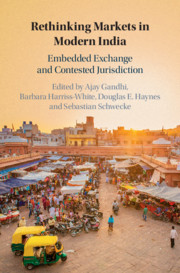Book contents
- Rethinking Markets in Modern India
- Rethinking Markets in Modern India
- Copyright page
- Contents
- Figures
- Tables
- Contributors
- 1 Markets in Modern India: Embedded, Contested, Pliable
- 2 Banking in the Bazaar: The Nattukottai Chettiars
- 3 Space in Motion: An Uneven Narrative of Urban Private Property in Bombay
- 4 Magic of Business: Occult Forces in the Bazaar Economy
- 5 Vernacular Capitalism, Advertising, and the Bazaar in Early Twentieth-Century Western India
- 6 The Artifice of Trust: Reputational and Procedural Registers of Trust in North Indian “Informal” Finance
- 7 Mandi Acts and Market Lore: Regulatory Life in India’s Agricultural Markets
- 8 The Market and the Sovereign: Politics, Performance, and Impasses of Cross-LOC Trade
- 9 Brandism vs. Bazaarism: Mediating Divinity in Banaras
- 10 Black Money in India: Fighting Specters and Fostering Relations
- 11 Market Making in Punjab Lotteries: Regulation and Mutual Dependence
- 12 Liquid Assets: Transactional Grammars of Alcohol in Jharkhand
- 13 Building on Sand? Criminal Markets and Politics in Tamil Nadu
- Index
- References
5 - Vernacular Capitalism, Advertising, and the Bazaar in Early Twentieth-Century Western India
Published online by Cambridge University Press: 24 September 2020
- Rethinking Markets in Modern India
- Rethinking Markets in Modern India
- Copyright page
- Contents
- Figures
- Tables
- Contributors
- 1 Markets in Modern India: Embedded, Contested, Pliable
- 2 Banking in the Bazaar: The Nattukottai Chettiars
- 3 Space in Motion: An Uneven Narrative of Urban Private Property in Bombay
- 4 Magic of Business: Occult Forces in the Bazaar Economy
- 5 Vernacular Capitalism, Advertising, and the Bazaar in Early Twentieth-Century Western India
- 6 The Artifice of Trust: Reputational and Procedural Registers of Trust in North Indian “Informal” Finance
- 7 Mandi Acts and Market Lore: Regulatory Life in India’s Agricultural Markets
- 8 The Market and the Sovereign: Politics, Performance, and Impasses of Cross-LOC Trade
- 9 Brandism vs. Bazaarism: Mediating Divinity in Banaras
- 10 Black Money in India: Fighting Specters and Fostering Relations
- 11 Market Making in Punjab Lotteries: Regulation and Mutual Dependence
- 12 Liquid Assets: Transactional Grammars of Alcohol in Jharkhand
- 13 Building on Sand? Criminal Markets and Politics in Tamil Nadu
- Index
- References
Summary
This chapter examines the way small manufacturing firms in western India began to use advertisement in the print media to develop markets for their goods during the early twentieth century.The chapter suggests that advertising gave small producers an opportunity to create the cultural meanings of commodities far away from the point of production.In many cases, they sought to usurp the role of local mercantile actors in fashioning product meanings; that is, they attempted to disembed the process of meaning construction from their local contexts.The chapter explores how advertisements became central to the operations of three firms involved in making indigenous medicines: Amritdhara, Jadibuti, and Dhootapapeshwa.Though the efforts of small manufacturers to undercut the role of local agents were only partially successful and often led to new forms of embedment, advertising was crucial to the creation of a “vernacular capitalism” that has largely been ignored by scholars.
Keywords
- Type
- Chapter
- Information
- Rethinking Markets in Modern IndiaEmbedded Exchange and Contested Jurisdiction, pp. 116 - 146Publisher: Cambridge University PressPrint publication year: 2020
References
- 1
- Cited by

